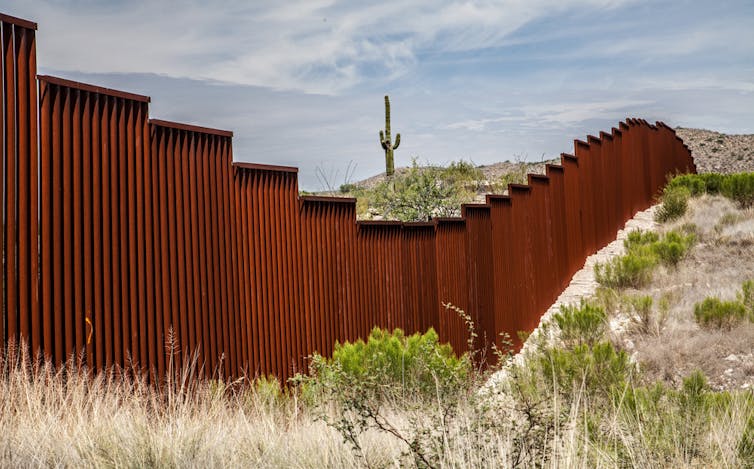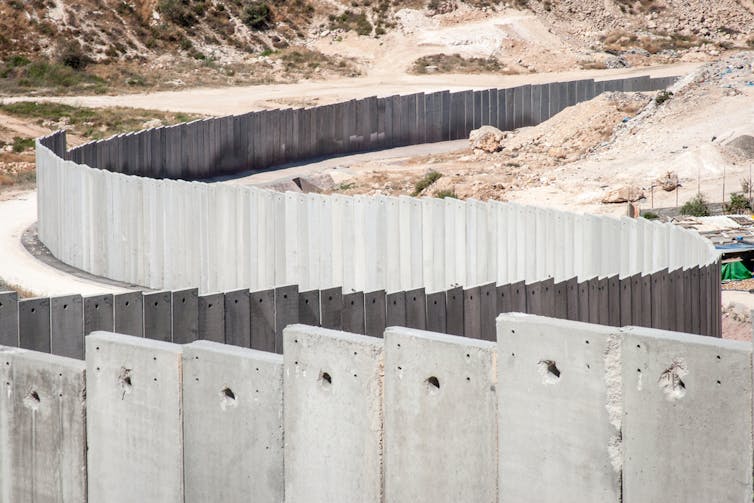
Nour Halabi, University of Leeds
Ever since his days on the election campaign trail the US president, Donald Trump, has assured voters of his intentions to build a wall along the US border with Mexico. He reiterated this promise during the 2019 State of the Union, and then declared a state of emergency soon after in order to access funding that Congress had rejected. It is now included on Trump’s 2020 re-election campaign website as part of a broader agenda to curb immigration.
Opponents of Trump’s border wall have dismissed the project as politically self-serving and financially frivolous. But arguments against the border wall have primarily focused on the cost to US taxpayers, suggesting economics as the most compelling framework through which a border wall project could be shot down.
Some others have focused on the environmental impact a border wall might have on the habitats and migration flows of North American wildlife.
It seems that many have avoided discussions of the moral issues raised by the border project and its long-lasting consequences for human civilisation. By contrast, Trump doesn’t rely on fiscal responsibility to justify his project, stressing his administration’s “moral duty to create an immigration system that protects the lives and jobs of […] citizens.”
But it is the moral costs of the border wall that should raise the greatest concern for the world at large. In my study on the lasting impact of border walls on society, I examined centuries of history and politics to uncover the consequences of the ancient walls surrounding Damascus on present-day Syrian society.
Those Roman walls, built around the 3rd century AD were intended to protect the city and its inhabitants from invaders. They surrounded the city, allowing inhabitants to enter and exit at seven points, the famous seven gates of Damascus. In 749 AD, Abu Abbas al-Saffah destroyed the walls during his overthrow of the Umayyad Caliphate, leaving only a small portion that extended from the Bab Touma gate to the Bab al Salam gate.
Today, long after they were destroyed, the Roman walls continue to have an effect on the structure of Syrian society, dictating marriages, business networks, and many other elements of socio-economic status. There are websites which list the family names of notables who historically resided “within” the city walls, bestowing an enduring distinction on generations of Syrians born with last names like the one my mother bore.
These contemporary practices suggest that the Roman walls continue to divide society along the lines of “Jouwwa” (inside) and “Barra” (outside), discriminating against those who live beyond their boundaries as “other”.
In a recent book chapter, I argue that walls act as communication devices that symbolise belonging or otherness to the communities that reside within and outside their bounds. As the archaeologist Oliver Creighton has commented:
The image of the walled city might outwardly be one of enclosure, cohesion, and privilege, equally important but underestimated is the enduring role of walled heritage in excluding […] populations.
Humanity, interrupted
Walls communicate protection and social cohesion to those living inside their bounds. They also symbolise a community’s “worthiness” of protection. By contrast, people beyond their bounds are deemed unworthy of protection. More importantly, they become a dehumanised part of the landscape that the internal “we” must be protected from.
This distinction was apparent when Trump stated that his administration was intent on ending “illegal immigration and putting the ruthless coyotes, cartels, drug dealers and human traffickers out of business.”

Most alarmingly, the dehumanisation of populations outside the boundaries of walls threatens violence towards these communities. It also impedes their movement into the centre, criminalising their mobility. As such, the plans to build a border wall – and the global proliferation of walls including between India and Bangladesh, and on the Hungarian border – suggests an ever-increasing militarisation of border crossing and mobility, with lethal consequences for migrants across the globe.
As legal expert Jaya Ramji-Nogales has said of global migration regimes, the world needs “alternate approach to global migration law”. This must begin by using evidence to challenge the escalating militarisation of border crossings in order to advocate for mobility as a fundamental human right that should not be curtailed by walls or borders.
It is telling that we acknowledge migration as a necessary part of life for most organisms on earth. Zoologists and conservationists trace the migration patterns of different land animals, birds and fish. Yet the approach to discussions on global migration flows fails to seriously consider migration as crucial to human civilisation. That needs to change.
Nour Halabi, Lecturer in Media and Communications, University of Leeds
This article is republished from The Conversation under a Creative Commons license. Read the original article.
